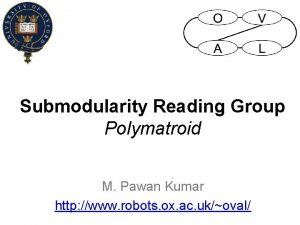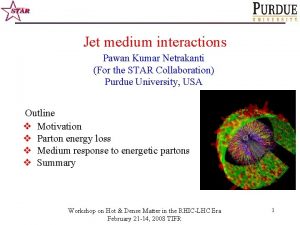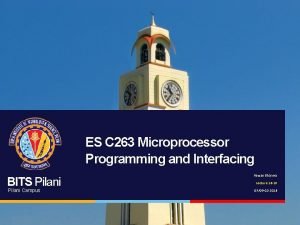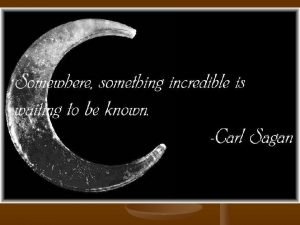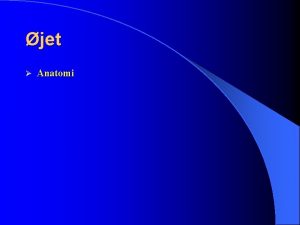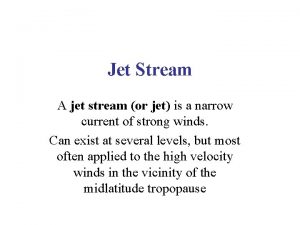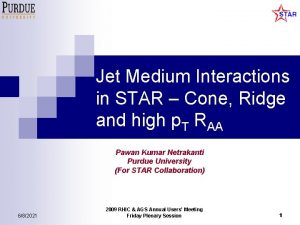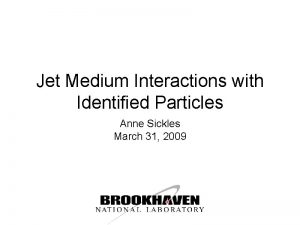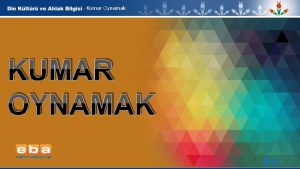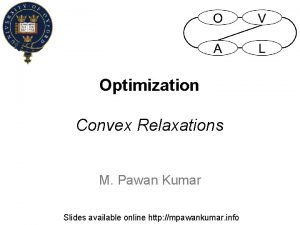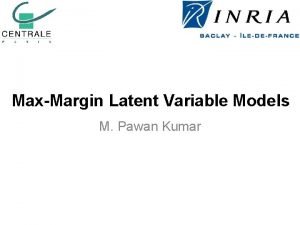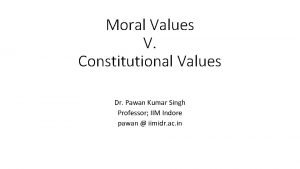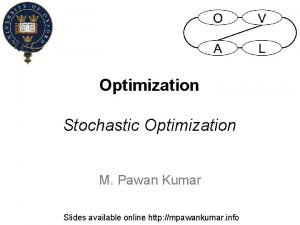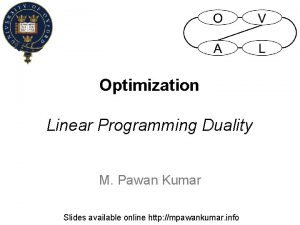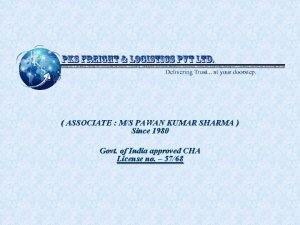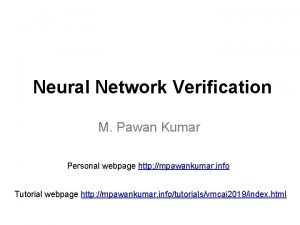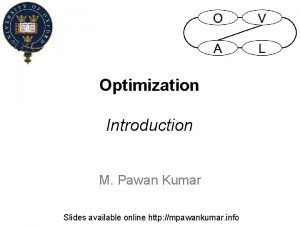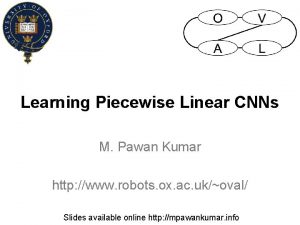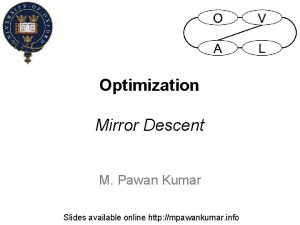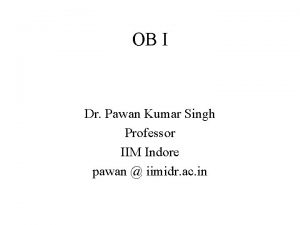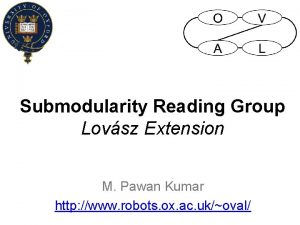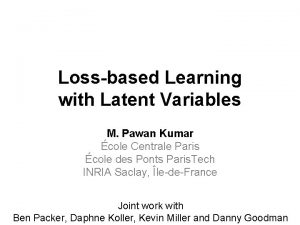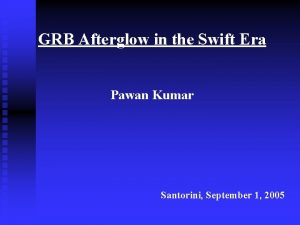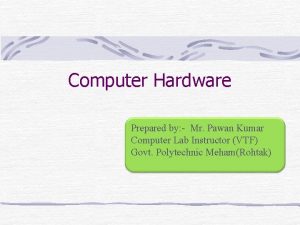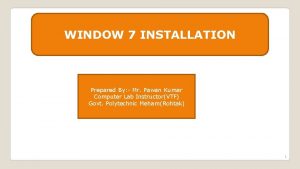Jet medium interactions Pawan Kumar Netrakanti For the




























- Slides: 28

Jet medium interactions Pawan Kumar Netrakanti (For the STAR Collaboration) Purdue University, USA Outline v Motivation v Parton energy loss v Medium response to energetic partons v Summary Workshop on Hot & Dense Matter in the RHIC-LHC Era February 21 -14, 2008 TIFR 1

Motivation Medium properties Physical phenomenon Experimental probes Energy density Parton Eloss in the medium High p. T particle production, and correlations Velocity of sound Mach cones 3 -particle correlations Partonic interactions Mechanism of Eloss Non-Abelian features of QCD Color factor effects, path length effects of Eloss Jet-medium coupling High p. T particle production and correlations, correlations with respect to reaction plane Collectivity and Thermalization Partonic collectivity, viscosity and interactions Azimuthal anisotropy Medium effect on particle production mechanism Parton recombination, modified/vacuum fragmentation Identified particle correlations Correlations play a significant role in understanding medium properties 2

Basic approach Calibrated probe Look for modification Medium formed in heavy-ion collisions j STAR Preliminary New STAR high p. T p+p results Jet and high p. T particle production in pp understood in p. QCD framework Near side Leading/trigger particle Associated particles Absence of medium Away side near STAR : PRL 97 (2006) 252001 STAR : PLB 637 (2006) 161 Is there any modification in heavy ion collisions ? away 3

Advantage of di-hadron correlations Di-hadron Single y (fm) x (fm) Less surface bias x (fm) Limited sensitivity of RAA to P( E, E) T. Renk, PRC 74 (2006) 034906 T. Renk and Eskola, hep-ph/0610059 2 IAA 2 RAA Di-hadron correlations more robust probes of initial density ~ 4 H. Zhong et al. , PRL 97 (2006) 252001

Current observations in STAR High p. T suppression Parton Eloss Away side yield modification p. Tlp : 4 - 6 Ge. V/c STAR : PLB 655 (2007) 104 STAR : PRL 97 (2006) 152301 STAR : PRL 91 (2003) 072304 p. Tasoc : 2 Ge. V/c - p. Tlp Away side shape modification 2. 5 < p. Ttrig< 4 Ge. V/c 1< p. Tassoc < 2. 5 Ge. V/c Medium response Enhanced correlated yield at large on near side d+Au Au+Au STAR: PRL 95 (2005) 152301 J. G. Ulery, QM 2005 STAR : J. Putschke, QM 2006 STAR : M. J. Horner, QM 2006 p. Ttrig=3 -6 Ge. V/c, 2 Ge. V/c <p. Tassoc< p. Ttrig Reappearance of di-jets How can we understand these features ? STAR : PRL 97 (2006) 162301 5

Do they give answers to … Mechanism of energy loss in medium - ØFew hard interactions or multiple soft interactions ? ØWhat is the Path length dependence of energy loss ? - L 2 or L ØWhat is the probability distribution of parton energy loss? ØDo partons loose energy continuously or discretely? Where does the energy from the absorbed jets go or how are they distributed in the medium? Shock waves in recoil direction Coupling of radiation to collective flow 6

Di-hadron fragmentation function (Away side) z. T=p. Tassoc/p. Ttrig 1/Ntrig d. N/dz. T 6< p. T trig < 10 Ge. V IAA STAR Preliminary Npart IAA ü Inconsistent with PQM calculations z. T ü Denser medium in central Au+Au collisions compared to central Cu+Cu ü z. T distributions similar for Au+Au and Cu+Cu for similar Npart ü Modified fragmentation model better C. Loizides, Eur. Phys. J. C 49, 339 -345 (2007) H. Zhong et al. , PRL 97 (2006) 252001 7

Di-hadron correlations w. r. t reaction plane in-plane S=0 trigger in-plane 3< p. Ttrig < 4 Ge. V/c, out-of-plane S=90 o p. Tassoc : 1. 0 - 1. 5 Ge. V/c 20 -60% STAR Preliminary trigger out-of-plane Au+Au 200 Ge. V top 5% STAR Preliminary d+Au Observations : ü 20 -60% : away-side : from single-peak (φS =0) to double-peak (φS =90 o) ü Top 5% : double peak show up at a smaller φS ü At large φS, little difference between two centrality bins 8

Path Length Effects STAR Preliminary v 2 sys. error RMS = i ( i - )2 yi i yi RMS v 2{RP} In-plane: v 2{4} similar to d. Au in 20 -60%. broader than d. Au in top 5%. Au+Au 200 Ge. V 3< p. Ttrig < 4 Ge. V/c 1. 0 < p. Tasso < 1. 5 Ge. V/c Out-of-plane: not much difference between the two centrality bins. Away-side features reveal path length effects 9

Conical Emission near STAR Preliminary d. Au STAR Preliminary Medium away deflected jets ( 1 - 2)/2 Conical emission or deflected jets ? Experimental evidence of T-trig < 4 Ge. V/c Conical emission 13<<pp. T-assoc < 2 Ge. V/c Two component approach near -Correlated to trigger (jets. . ) - Uncorrelated to trigger (except via anisotropic flow) Bkg normalization 3 -particle ZYAM Medium away Conical Emission ( 1 - 2)/2 Central Au+Au 0 -12% 10

Cone angle (radians) Mach Cone or Cerenkov Gluons C 3 STAR Preliminary p. T (Ge. V/c) ü Mach-cone: Angle independent of associated p. T ü Cerenkov gluon radiation: Decreasing angle with associated p. T STAR Preliminary Subtraction of v 2 v 2 v 4 terms using on v 2 = 0. 06 Subtraction of v 2 v 2 v 4 term using v 2 = 0. 12 Strength and shape of away side structures observed depends on assumed magnitude of flow coefficients In cumulant approach: no conclusive evidence for conical emission so far Claude Pruneau : STAR : QM 2008(Poster), PRC 74 (2006) 064910 Naively the observed cone angle ~ 1. 36 radians leads to very small (time averaged) velocity of sound in the medium 11

Ridge in Heavy Ion Collisions Au+Au d+Au, 40 -100% Au+Au, 0 -5% 3 < p. T(trig) < 6 Ge. V 2 < p. T(assoc) < p. T(trig) What does these features reveal about the medium ? Can we get an idea about the energy lost by partons in the medium? 12

Features of the Ridge (at QM 2006) STAR Preliminary J. Putschke (QM 06) Yield at large independent on STAR : J. Putschke, QM 2006 STAR Preliminary Ridge persists up to high p. T-trig TRidge ~ Tinclusive < Tjet Indication of two contributions Jet contribution + contribution arising due to jet propagating in the medium 13

Jet and Ridge : Observations üNear-side jet yield independent of colliding system, Npart and trigger particle type üHigh p. T-trig leads to higher jet yields Supports : Parton fragmentation after parton Eloss in the medium üRidge yield increases with Npart 14

Particle Ratios: Jet & Ridge Jet Cone vs. Inclusive Ridge vs. Inclusive STAR Preliminary Jet e ridg Jet : /K 0 s ~ 0. 5 < inclusive Ridge : /K 0 s ~ 1 ~ inclusive ü Ratios in cone smaller than inclusive ü Ratios in ridge similar to inclusive 15

Theoretical model interpretations 1)In medium radiation + longitudinal flow push N. Armesto et. al Phys. Rev. Lett. 93(2004) 242301 3)Turbulent color fields A. Majumder et. al Phys. Rev. Lett. 99(2004)042301 5)Recombination between thermal and shower partons R. C. Hwa & C. B. Chiu Phys. Rev. C 72 (2005) 034903 2)Transverse flow boost S. A. Voloshin, Phys. Lett. B. 632(2006)490 E. Shuryak, hep-ph: 0706. 3531 4)Momentum Kick C. Y. Wong hep-ph: 0712. 3282 Can we discriminate between these physics interpretations? 3 -particle Correlation in 16

Motivation for 3 -particle correlation in 2 1 T : Trigger particle A 1: First Associated particle A 2: Second Associated particle STAR TPC acceptance for 3 -particle correlation in (| |<1 and full azimuth) 1 = A 1 -T 2 = A 2 -T 1) Jet fragmentation in vacuum 2) In medium radiated gluons diffused in 3) In medium radiated gluons still collimated 4) Combination between jet fragmentation and diffused gluons 17

Analysis techniques Au+Au and d+Au at s. NN = 200 Ge. V Trigger : 3<p. T<10 Ge. V/c, | |<1 Associated : 1< p. T<3 Ge. V/c, | |<1 Select both associated particles Near Side: | | <0. 7 STAR Preliminary Away Side: | - |<0. 7 Mixed events to obtain background : (a) Min-bias events with same centrality (b) (primary vertex z) < 1 cm (c) Same magnetic field configuration 18

3 -particle correlation background correlated - - Ø Raw Raw signal Ø Raw Bkg Hard-Soft Ø Bkg 1 Soft-Soft Ø Bkg 1 Bkg 2 19

3 -particle correlation (| |<0. 7) d. Au STAR Preliminary d. Au 3<p. TTrig<10 Ge. V/c 1<p. TAsso<3 Ge. V/c STAR Preliminary 2 -particle Correlation STAR Preliminary Au. Au 40 -80% 0. 7<R<1. 4 STAR Preliminary Au. Au 0 -12% Shaded : sys. error. Line : v 2 uncer. Au. Au 0 -12% 20

Comparison (Projections) 3<p. TTrig<10 Ge. V/c 1<p. TAsso<3 Ge. V/c | | <0. 7 STAR Preliminary 0. 7<R<1. 4 Au. Au 0 -12% is higher than d. Au and Au. Au 40 -80% 21

Summarizing … 3 -particle correlation in - 3<p. TTrig<10 Ge. V/c, 1<p. TAsso<3 Ge. V/c, | |<0. 7 d. Au STAR Preliminary Au. Au 40 -80% Au. Au 0 -12% STAR Preliminary ØThe ridge is approximately uniform or broadly falling with . ØNo significant structures along diagonals or axes. Ridge + = Ridge is uniform event by event. Jet 22

Potential for away-side analysis STAR Preliminary 3<p. TTrig<10 Ge. V/c 1<p. TAsso<3 Ge. V/c | - | <0. 7 Another tool to study Ridge 3<p. Ttrig<4 Ge. V/c 1. 0<p. Tasso<1. 5 Ge. V/c STAR Preliminary Study the ridge with the help of Di-hardon correlation w. r. t. reaction plane. 23

Summary : Medium Response Strong jet-medium interaction observed. ü Signals of conical emission observed in central Au+Au collisions at 200 Ge. V in 2 -component approach ü Medium responds through ridge formation. ü New observations should provide significant constrains on the mechanism of ridge formation ü Particle ratios in ridge similar to inclusive measurements ü Di-hadron correlations with respect to reaction plane indicates - ridge is dominated in-plane, consistent with medium density effect STAR Preliminary Ridge vs. Bulk STAR Preliminary Jet Cone vs. Bulk STAR Preliminary 24

Summary: Meduim Response Ø Three-particle correlation in - can potentially identify the underlying physics of the ridge. Ø Correlation peak at = ~0, characteristic of jet fragmentation, is observed in d+Au, Au+Au 40 -80% and central Au+Au 0 -12%. Ø The peak sits atop of pedestal in central Au+Au. This pedestal, composed of particle pairs in the ridge, is approximately uniform or broadly falling with in the measured acceptance. No significant structures along diagonals or axes. ØSignificant step forward in experimental study. Quantitative theoretical calculations are needed for further understanding. 25

Thanks to STAR Collaboration Argonne National Laboratory Institute of High Energy Physics - Beijing University of Birmingham Brookhaven National Laboratory University of California, Berkeley University of California - Davis University of California - Los Angeles Universidade Estadual de Campinas Carnegie Mellon University of Illinois at Chicago Creighton University Nuclear Physics Inst. , Academy of Sciences Laboratory of High Energy Physics - Dubna Particle Physics Laboratory - Dubna Institute of Physics. Bhubaneswar Indian Institute of Technology. Mumbai Indiana University Cyclotron Facility Institut Pluridisciplinaire Hubert Curien University of Jammu Kent State University of Kentucky Institute of Modern Physics, Lanzhou Lawrence Berkeley National Laboratory Massachusetts Institute of Technology Max-Planck-Institut fuer Physics Michigan State University Moscow Engineering Physics Institute City College of New York NIKHEF and Utrecht University Ohio State University Panjab University Pennsylvania State University Institute of High Energy Physics - Protvino Purdue University Pusan National University of Rajasthan Rice University Instituto de Fisica da Universidade de Sao Paulo University of Science and Technology of China Shanghai Institue of Applied Physics SUBATECH Texas A&M University of Texas - Austin Tsinghua University Valparaiso University Variable Energy Cyclotron Centre. Kolkata Wayne State University Warsaw University of Technology University of Washington Institute of Particle Physics 26 Yale University of Zagreb

Back up 27

2 -particle correlation Au. Au ZDC central (0 -12%) triggered data, 3<p. TTrig<10 Ge. V/c, 1<p. TAsso<3 Ge. V/c Black : Raw signal Pink : Mixed-event background Blue : Scaled bkgd by ZYA 1 Red : Raw signal – bkgd STAR Preliminary | |<0. 7 acceptance corrected Ridge 28
 Submodular function
Submodular function Kumar kom jet
Kumar kom jet Yelvington jet aviation aircraft fuel
Yelvington jet aviation aircraft fuel Pawan sharma bits pilani
Pawan sharma bits pilani Hot and cool media
Hot and cool media Vydj
Vydj Handledning reflektionsmodellen
Handledning reflektionsmodellen Shingelfrisyren
Shingelfrisyren Borstål, egenskaper
Borstål, egenskaper Verktyg för automatisering av utbetalningar
Verktyg för automatisering av utbetalningar Shaktismen
Shaktismen Jätte råtta
Jätte råtta Vad är hsil
Vad är hsil Jag har nigit för nymånens skära text
Jag har nigit för nymånens skära text Strategi för svensk viltförvaltning
Strategi för svensk viltförvaltning Anatomi organ reproduksi
Anatomi organ reproduksi Stig kerman
Stig kerman Informationskartläggning
Informationskartläggning Typiska novell drag
Typiska novell drag Tack för att ni har lyssnat
Tack för att ni har lyssnat Läkarutlåtande för livränta
Läkarutlåtande för livränta Klassificeringsstruktur för kommunala verksamheter
Klassificeringsstruktur för kommunala verksamheter Centrum för kunskap och säkerhet
Centrum för kunskap och säkerhet Inköpsprocessen steg för steg
Inköpsprocessen steg för steg Påbyggnader för flakfordon
Påbyggnader för flakfordon Tack för att ni lyssnade
Tack för att ni lyssnade En lathund för arbete med kontinuitetshantering
En lathund för arbete med kontinuitetshantering Egg för emanuel
Egg för emanuel Tack för att ni har lyssnat
Tack för att ni har lyssnat
